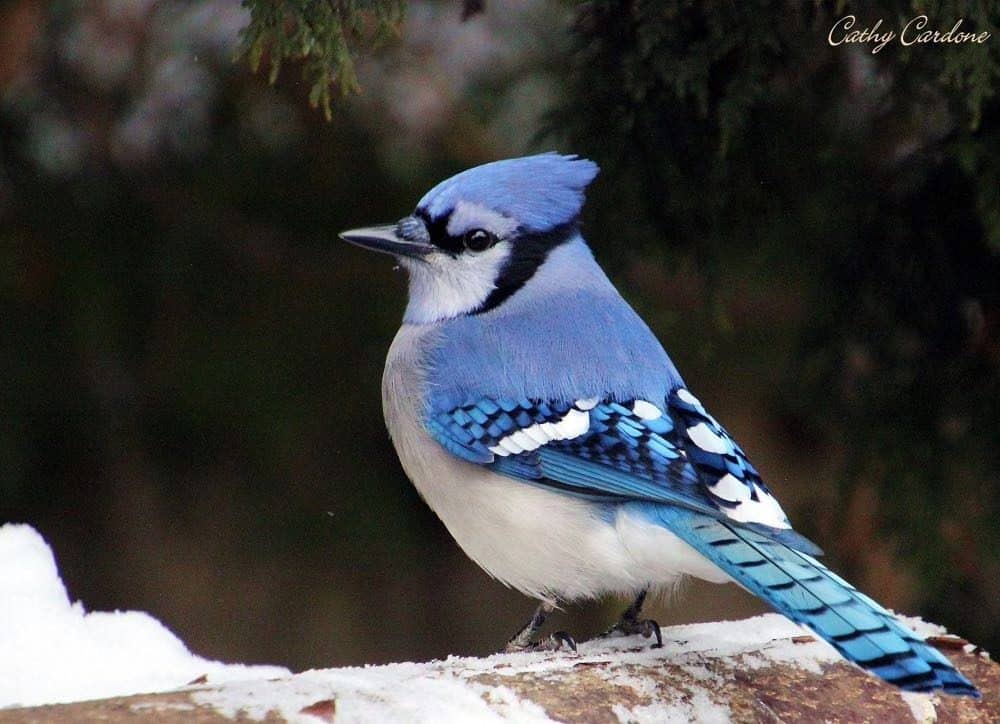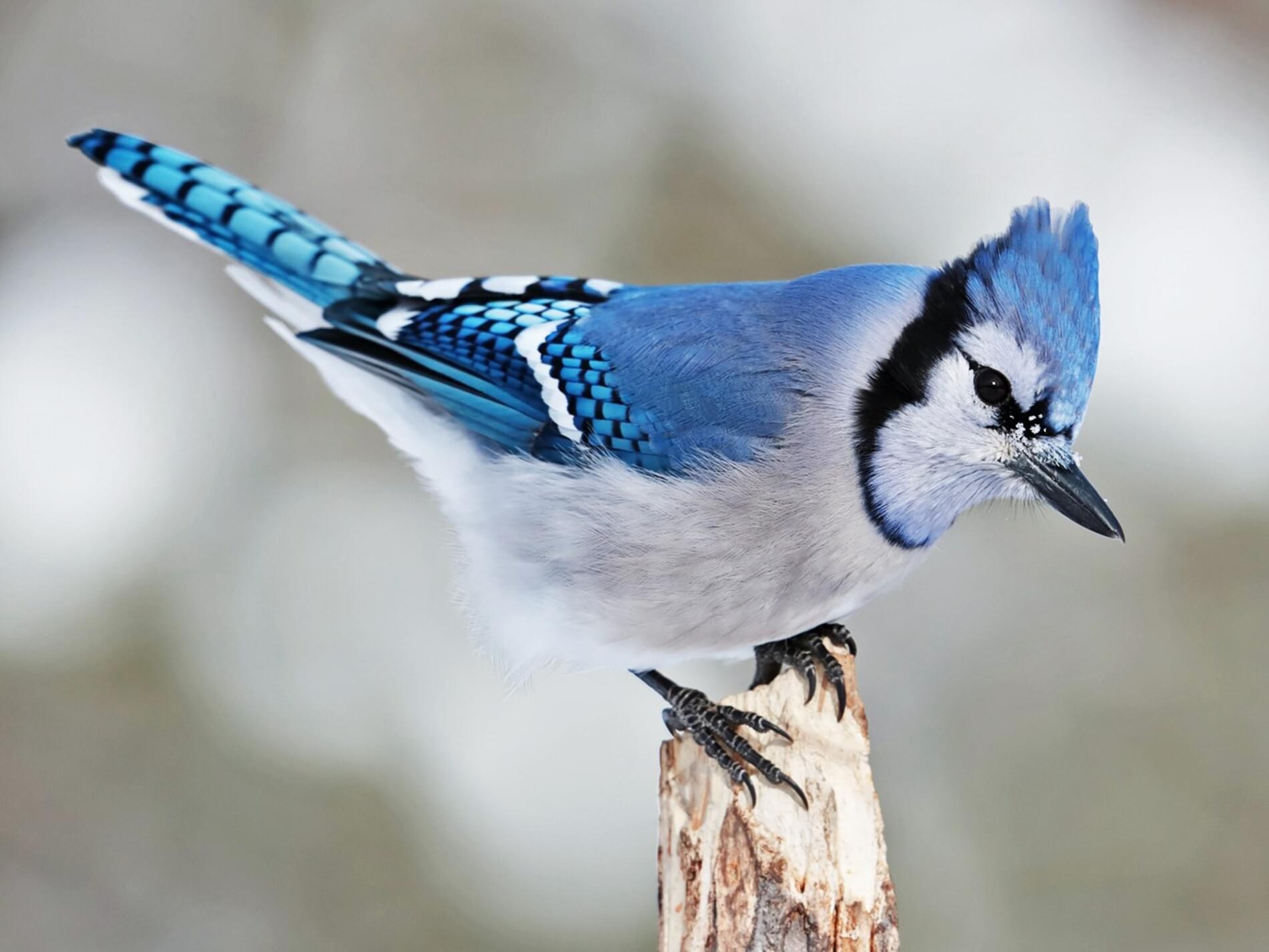Blue Jay Biology and Behavior

The blue jay (Cyanocitta cristata) is a striking and intelligent bird that is a familiar sight across North America. Its distinctive plumage, bold behavior, and complex vocalizations make it a fascinating subject of study for ornithologists and bird enthusiasts alike.
Physical Characteristics
Blue jays are medium-sized birds, measuring approximately 10-12 inches in length with a wingspan of 16-20 inches. Their most prominent feature is their bright blue plumage, which covers their head, back, wings, and tail. The blue jay’s wings and tail are tipped with white, creating a striking contrast against the dark blue. Their underparts are white, and their head features a distinctive black “mask” that extends around the eyes and down the throat. The blue jay also has a prominent crest of feathers on its head, which it can raise or lower depending on its mood.
Habitat Preferences and Geographic Distribution
Blue jays are found throughout eastern and central North America, ranging from southern Canada to the Gulf Coast. They are adaptable birds and can thrive in a variety of habitats, including forests, woodlands, parks, and suburban areas. They prefer mature deciduous forests with a mix of trees and shrubs, as these habitats provide them with ample nesting sites, food sources, and cover from predators.
Diet, Foraging Habits, and Role in the Ecosystem
Blue jays are omnivorous birds with a diverse diet. They primarily feed on nuts, seeds, fruits, and insects, but they also consume small animals like reptiles, amphibians, and even bird eggs. They are opportunistic feeders and will readily scavenge for food at bird feeders, garbage dumps, and picnic areas. Blue jays are important seed dispersers, playing a vital role in the regeneration of forests by caching nuts and seeds in the ground. They also help to control populations of insects and other small animals, contributing to the overall health of the ecosystem.
Mating and Nesting Behaviors
Blue jays are monogamous birds, forming strong pair bonds that can last for several years. They typically breed in the spring, building their nests in trees, usually high up in the branches. The nest is a bulky structure made of twigs, bark, and other materials, and is lined with softer materials like grasses, feathers, and hair. The female lays 3-7 eggs, which are incubated for about 17 days. Both parents share the responsibility of incubating the eggs and feeding the young. Blue jay chicks are altricial, meaning they are born blind and featherless, and require extensive care from their parents.
Vocalizations
Blue jays are known for their loud and varied vocalizations. Their calls include a harsh “jay” or “jay-jay” sound, which they use for communication and alarm. They also produce a variety of other calls, including whistles, chirps, and rattles. Blue jays are known for their mimicry abilities, and they can imitate the calls of other birds, as well as other sounds, such as car horns and human voices.
Blue Jay Cultural Significance: Blue Jays

The blue jay, with its striking plumage and boisterous calls, has held a significant place in human cultures for centuries. Beyond its ecological role, the blue jay has been woven into the fabric of folklore, mythology, and artistic expression, becoming a symbol of various concepts and beliefs.
Blue Jays in Native American Folklore and Mythology
The blue jay has long been a prominent figure in the oral traditions and mythology of various Native American tribes. It often symbolizes intelligence, communication, and the spirit world. For instance, the Cherokee people believe that the blue jay was once a human who was punished for stealing food and transformed into a bird. This tale highlights the blue jay’s association with trickery and mischief. In other cultures, the blue jay is revered as a messenger of the gods or a protector of the forest.
Blue Jays in Literature, Art, and Popular Culture
The blue jay’s distinctive appearance and behavior have inspired countless artists and writers. In literature, the blue jay has been featured in works by renowned authors such as Henry David Thoreau and Ernest Hemingway, often symbolizing the wildness and resilience of nature. In art, the blue jay has been depicted in paintings, sculptures, and photography, capturing its vibrant colors and intricate patterns. The blue jay has also found its way into popular culture, appearing in movies, television shows, and even video games.
Symbolism Associated with the Blue Jay
The blue jay’s symbolism varies depending on the culture and context, but some common themes emerge. Its intelligence is often attributed to its ability to mimic sounds and its cleverness in finding food. The blue jay’s adaptability is reflected in its ability to thrive in diverse environments and its resourcefulness in foraging. Its loud and distinctive calls symbolize communication and the ability to convey messages.
Cultural Interpretations of the Blue Jay
| Culture | Interpretation |
|---|---|
| Cherokee | Trickster, punished for stealing food |
| Iroquois | Messenger of the gods |
| Cree | Protector of the forest |
| Blackfoot | Symbol of strength and courage |
Blue Jay-Themed Proverbs, Sayings, and Idioms
The blue jay’s unique characteristics have inspired numerous proverbs, sayings, and idioms. Some examples include:
- “As busy as a blue jay” – This proverb describes someone who is constantly active and energetic.
- “A blue jay’s cry” – This saying refers to a sudden and unexpected event.
- “To have a blue jay’s memory” – This idiom describes someone who has a poor memory.
Conservation and Challenges Facing Blue Jays
While the blue jay is a common sight across much of North America, its population faces several challenges that threaten its long-term survival. Understanding these threats is crucial for implementing effective conservation strategies.
Threats to Blue Jay Populations
- Habitat Loss: As human development encroaches on natural landscapes, blue jay habitat is fragmented and reduced. This includes deforestation for agriculture, urbanization, and suburban sprawl. Blue jays rely on mature forests for nesting, foraging, and shelter, and the loss of these habitats directly impacts their populations.
- Climate Change: Climate change poses a significant threat to blue jay populations. Rising temperatures, altered precipitation patterns, and more frequent extreme weather events can disrupt breeding cycles, reduce food availability, and increase vulnerability to disease.
- Disease: Avian diseases, such as West Nile virus and avian pox, can impact blue jay populations. These diseases can cause mortality, especially in young or weakened birds, and can also affect their reproductive success.
Current Conservation Status and Efforts
The blue jay is currently classified as a species of “Least Concern” by the International Union for Conservation of Nature (IUCN). This means that the species is not facing an immediate threat of extinction. However, ongoing monitoring and conservation efforts are necessary to ensure the long-term survival of the blue jay.
Human Activities and Their Impacts
Human activities can significantly impact blue jay populations. For example, the use of pesticides and herbicides in agriculture can reduce food availability and expose birds to toxins. Furthermore, habitat fragmentation due to roads and development can isolate populations, reducing genetic diversity and making them more vulnerable to disease.
Challenges and Opportunities for Blue Jay Conservation
| Challenges | Opportunities |
|---|---|
| Habitat loss and fragmentation | Protecting and restoring forests, promoting sustainable land management practices |
| Climate change | Reducing greenhouse gas emissions, adapting to changing climate conditions |
| Disease | Monitoring disease outbreaks, promoting healthy bird populations |
| Human activities | Educating the public about blue jay conservation, reducing pesticide use |
Blue Jay Habitat Restoration Project
A notable example of a blue jay habitat restoration project is the “Reforesting for the Future” initiative in the Appalachian Mountains. This project aims to restore degraded forest ecosystems by planting native trees, creating wildlife corridors, and promoting sustainable forestry practices. The project has seen a significant increase in blue jay populations within the restored areas, demonstrating the effectiveness of habitat restoration efforts.
Blue jays, with their vibrant plumage and raucous calls, are a familiar sight in the woodlands of the eastern United States. Their presence, much like the Atlanta Braves , evokes a sense of nostalgia and a connection to the natural world.
As the Braves, with their storied history, have brought joy and excitement to fans, the blue jays, with their playful antics and bold colors, remind us of the beauty and wonder that surrounds us.
The blue jay, with its vibrant plumage, seems to embody a kind of defiant spirit, a flash of color against a gray sky. Perhaps it’s this same spirit that resonates with the New York Yankees , a team steeped in history and tradition, known for their unwavering ambition.
Like the blue jay, the Yankees have a way of leaving their mark, a legacy that echoes through generations. The blue jay, though, remains a solitary figure, flitting from branch to branch, a reminder that even the most vibrant displays can be fleeting.

